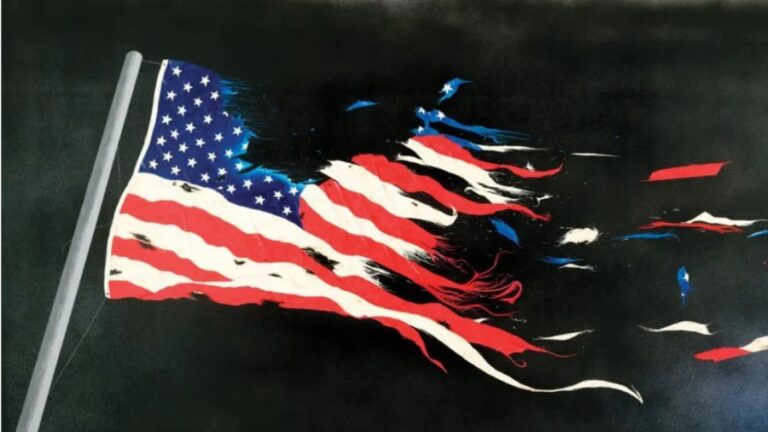American Civil War: Of Roman Plagues, Handmaid’s Tales & the Real Geopolitics of Fiction
Biden’s foreign policy and his attitude to the EU seems to be a clone of Trump’s. Which oddly and incredibly, lends more to the Handmaid scenario than it does Black Mirror.
How can we explain how Australia, Britain, Austria, Italy, and more have gone the path of arbitrary and capricious detention and exclusion from society? The Austrian government mobilized perhaps 500 people into the streets in support of lockdown and apartheid measures, colluding with media to inflate that number by a massive factor of sixty.
The reactions to this certainly represent an extreme polarization of society. Yet in politics, there are no coincidences. So while the ruling class would prefer little resistance by some metrics, the popularization of resistance and the potentials this arena holds are also promising in elite contingency planning. Such will be our primary focus in this review.
Whichever holds the most potential and handles resistance in the best way, while carrying out some form of the underlying plan, will be the version of the plan the managers attempt to deliver for the elites.
And this presents a great danger; those still capable of thinking being demoralized by the state of humanity, and drawing eugenicist conclusions parallel to those of the elites. After all, how can the great herd of humanity acquiesce in such a way? If there is a lesson to be learned from history, perhaps it is not ‘never again!’ so much as ‘it will always happen again’.
While the state and corporate sanctioned hatred espoused by media to the unvaxed has reached an alarming temperature, the counter-narrative of blaming the ‘sheeple’ for the new age of mass house-arrest and social apartheid is also growing.
While one is situated as an overt policy of the state apparatus, the other builds popular support and has all the trappings and bearings of authenticity, people power, life, and motion.
Roman Plagues, Inflation, and Great Awakening
In 168 AD the Greek physician Galen was summoned by the synarchy of Marcus Aurelius and Lucius Verus then ruling the Roman Empire, to provide guidance on the management of the small-pox pandemic then affecting millions, now called the Antonine Plague.

Then as now, according to Sabbatani and Fiorino (Infez Med. 2009 Dec;17(4):261-75), the primary factors that led to the pandemic were underlying conditions: primarily poor sanitation and hygiene, and poor diet and access to food. A disproportionate number of Roman subjects lived in overcrowded cities, and lived at the hands of landlords, speculators, and the average life expectancy had dropped to around 25.
Then as now, all of these factors were socially constructed and were not merely ‘facts of life’ as if handed down by the gods, but rather were conditions imposed upon the great mass of humanity by an unhinged oligarchy.
Whether this plague was seen as beneficial by the oligarchy, for whom – then as now – maintenance of a declining population rate was subsidized by coordinated migration from the reaches of the empire – is a subject of debate. Did they see the unwashed rabble in the back alleys of the metropolis as useless eaters, then as they do now?
At any rate, history views the Antonine Plague as a turning point, after which came an age of inflation and division from which the Roman Empire is said to have never fully recovered. The response to the plague from Christians, with their care for the ill, is also a factor in the rapid growth of this monotheism in the empire.
Ultimately Lucius Verus would himself succumb to the mystery illness the following year in 169, and perhaps it is lessons as these which provide for us some insight into new methods of biological warfare when class war is the proscribed remedy for surplus population. If manufacturing such a contagion, it would make sense that it be no more lethal than the common cold, and that nevertheless the concentration of power and an economic regimen which also decreased lives and livelihoods could be obtained at a far smaller cost.
The Antonine and then Cyprian Plague in the 3rd century AD would together lead towards an increased mysticism, religiosity, and tended towards the rapid ascension of Christianity.
Then, as now, the scenario fuels the ‘Great Awakening’, and public embrace of conspiracy theories is at an all-time high, just as mysticism and superstitions also grew through the Roman Empire during these centuries.
Problem-Reaction-Solution, and other things unrelated to Hegel
It is said that history repeats or at the very least parallels, but rather than ascribe these to abstract and still mysterious iron laws of history or any providence directing these, perhaps instead these events return and return again because they are methods of control that work. As Marx said, when history does repeat, the first is tragedy, the second is farce.
The farce at hand today no doubt is that the plague is real and yet also nary more deadly than the flu.
As we previously discussed, it was Foucault who shows convincingly that it was the first the authorized response to the plagues, with its systems of quarantine and mass surveillance, etcetera, that gave initial impulse and inspiration towards the construction of the first modern prisons a century or so later, with its panopticon.
But in regards to the growth of mysticism, paranoia, and religiosity, we see this growing in all areas, both for and against the mandates. Common now is the paranoia around infection, when the common cold never produced this except among germophobes, or in the ritualized wearing of masks which in fact ‘do’ nothing, or rather do something other than what is being publicly explained.
And on the other side, the rapacious and gratuitous abuses by the elites whose evil knows no bounds, has led to a kind of spiritual or religious awakening against the mandate.
Naturally those managing for those in power at the very top, above and beyond mere elected politicians and public health ‘experts’, understand this ‘problem-reaction-solution’ pattern which has so far worked for them.
So in light of that fact, we are drawn to a particularly problematic notice of potential danger scribbled in Schwab’s Covid-19 book. Here we are instructed to infer from the pattern and logic of the text so far, that if the Black Mirror dystopian scenario obviously preferred by the ruling class, with its social credit system – if this does not work – then we have a fall-back plan for a sort of Handmaid’s Tale scenario.

As ridiculous at face value as such things may have sounded just a few short years ago, here we are today with open eyes and open minds, understanding precisely such scenarios and their potentials. Schwab, for his part, does anyhow.
It is there on page 167 that we find it laid out in the standard cryptic fashion, that a fundamentalist theocracy is also something that elites have thought through potential outcomes.
That’s an awfully specific outcome, to be mentioned. The social credit scenario in the Black Mirror seems much more obvious, in part because we are already now living it.
What sorts of problems would be presented so that the reaction could produce that, specifically that, as a solution?
Interestingly, we have numerous factors lining up. While we have noted previously that the population ‘Great Replacement’ conspiracy theory popular in France and catching on in the U.S., is depicted in films like ‘Children of Men’, a common theme with that dystopia and the Handmaid’s Tale is a population and reproduction crisis.
The Geopolitics of Fiction
Perhaps it was Victoria ‘F*ck the EU’ Nuland who first truthfully articulated a shift in U.S. policy away from Trans-Atlanticism. Though, her faction still rests on this doctrine and Biden has struggled to make good on such a return to good EU relations after a stark departure during the Trump years.
But an isolated U.S. is a geopolitical factor in The Handmaid’s Tale. In the TV series version, a more thorough geopolitical situation is relayed to the audience. The premise of the story is that as the result of the overuse of GMOs with their terminator seeds, men’s sperm count rapidly declined. But because the broader crisis, it ushered in a neo-Puritan theocracy, and women were blamed for it. At the same time, the ‘war against boys and men’ theme was depicted as a problem in the U.S., the reaction to it being the formation of the ultra-conservative militant group with MRA beliefs infused with Christian fundamentalism that ultimately seizes power.
Undoubtedly, the elites prefer the Black Mirror scenario of a Trans-Atlanticist surveillance state, and indeed that it is not just a social credit state but a surveillance state is also mentioned on the same page 167 in the typical Schwabian manner. This is the method whereby the entire book can be understood, where certain kinds of ‘warnings’ are precisely the kinds of outcomes the ruling class wants. And we know this because they have actively, with tremendous gusto, pursued those outcomes for decades.
The surveillance state reference relates here to a disingenuous social-democratic nod to Shoshana Zuboff’s tome ‘Surveillance Capitalism’, mentioned also by Schwab on page 167 in connection to the dystopia warnings on the same page. Zuboff is a member of the establishment ‘temple’ in good standing, and also a member of the ‘state’.
Like Schwab, she explains the dangers of rapacious predatory capitalism while being a vociferous defender of its ethos. It may be hard for some to imagine how it’s possible to hold such positions while also selling one’s financial services to the very target of the same criticisms. But neuroticism and self-serving hypocrisy are par for the course in that world.
Schwab pretends to warn and lament that such an outcome like The Handmaid’s Tale is a possibility of certain societies like the U.S. , if they‘ mismanage’ the situation, by which we understand means ‘manage precisely as we want once the pushback forces us to’.
What do we mean here? While the Atlanticist model requires increased ideological harmony between the U.S. as Europe is instructed to ‘love’ a sort of strange cultural hybrid of intersectional ‘black struggle’ with something closer to home, cross-dressing, which a few decades ago we could simply call ‘RuPaul’.
And the U.S. is instructed to look at European ‘social democracy’ as an inspirational model, though in practice also it comes with less social and less democracy. But it is the ‘vibe’ of a state that provides welfare that matters, even as in the U.S. it doesn’t. It feels like it does when Democrats are in office.
So together there is some hegemonic ideological construct that conjoins Western Europe to the U.S., despite that spatially and economically Europe is more dependent on Eastern Europe, China and MENA.
A Swift Conclusion
There are also big pushes by some dissenting voices within the elites, who got behind Trump and may well still be behind him, that want to collapse Atlanticism all together, meaning the end of NATO but also the IMF, and so naturally those elite forces nevertheless bent on population reduction and their own preservation are looking at ways to manage the blowback as well.
For reasons beyond our scope here, Biden’s foreign policy and his attitude to the EU seems to be a clone of Trump’s. Which oddly and incredibly, lends more to the Handmaid scenario than it does Black Mirror.
Conclusively, while legal and constitutional pushes for election reform and a robust curtailment of the covid restrictions is in order, on our radar screen should be the manipulation of this resistance towards Christian theocratic aims – not because they challenge the status quo, but because they would be controlled by it.







